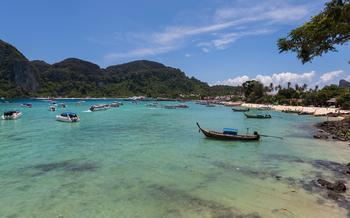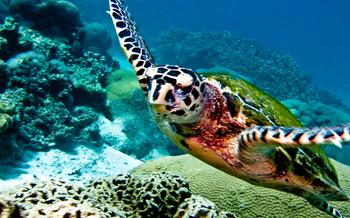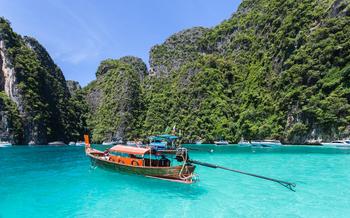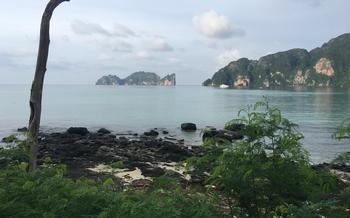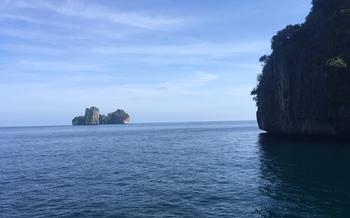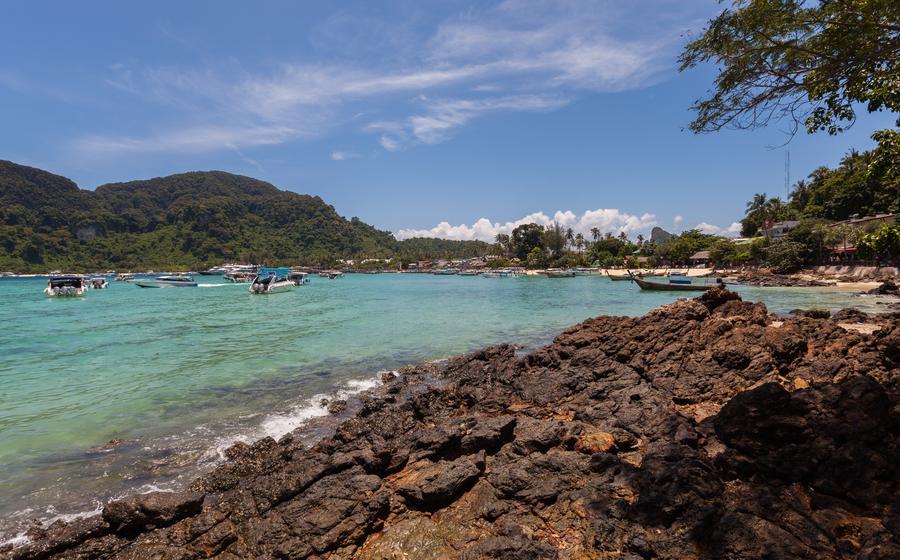
Shark Point
- Shark Point: An Overview
- Marine Life at Shark Point
- Snorkeling and Diving at Shark Point
- Shark Point's Coral Reefs
- Other Activities at Shark Point
- Best Time to Visit Shark Point
- What to Bring to Shark Point
- Safety Tips for Shark Point
- Shark Behavior and Encounters
- Local Culture and Customs
- Sustainable Tourism at Shark Point
- Accommodation and Dining Options
- Getting to Shark Point
- Off-the-Beaten-Path Experiences
- Insider Tip: Photography and Videography
Shark Point: An Overview
Shark Point is a world-renowned diving and snorkeling destination located just off the coast of the Phi Phi Islands, an archipelago in Southern Thailand. With its crystal-clear waters, vibrant coral reefs, and abundance of marine life, it offers an unforgettable experience for underwater enthusiasts.
Shark Point earned its name due to its high frequency of blacktip reef shark sightings. These magnificent creatures often gather in large schools, creating a breathtaking spectacle for divers and snorkelers alike. The site's diverse marine life also includes colorful tropical fish, sea turtles, rays, and moray eels.
Shark Point's underwater topography is as captivating as its marine life. The site features a series of shallow coral-rich plateaus that gradually slope down to deeper waters, creating a diverse range of habitats for marine species. The coral reefs here are known for their vibrant colors and intricate structures, providing shelter and food for a myriad of marine organisms.
The accessibility of Shark Point makes it an ideal destination for both experienced divers and beginners. The site can be easily reached by boat from the main island of Koh Phi Phi Don, and there are numerous dive shops and tour operators offering guided excursions to the site.
Marine Life at Shark Point
Shark Point is home to an incredible array of marine life that attracts snorkelers and divers from around the world. The site's vibrant coral reefs provide shelter and sustenance to a diverse community of fish species, including colorful damselfish, angelfish, and butterflyfish. Schools of yellowtail barracuda, batfish, and fusiliers glide through the water, while hawksbill and green sea turtles swim gracefully in the distance.
Blacktip Reef Sharks: The star attraction of Shark Point is undoubtedly the blacktip reef shark. These sleek and agile predators are commonly sighted in the area, often swimming in groups near the coral reefs. Blacktip reef sharks are generally shy and non-aggressive towards humans, but it is important to maintain a respectful distance and avoid any sudden movements that may startle them.
Seasonal Variations: The marine life at Shark Point varies throughout the year, influenced by seasonal changes in water temperature and currents. During the high season (November to April), the visibility is typically excellent, and the waters are calm, providing ideal conditions for snorkeling and diving. The cooler months (May to October) bring stronger currents and reduced visibility, but still offer opportunities to encounter a variety of marine life, including seasonal visitors such as whale sharks and manta rays.
Snorkeling and Diving at Shark Point
Shark Point offers a mesmerizing underwater world for both snorkelers and divers. The calm and clear waters provide excellent visibility, allowing you to witness the vibrant marine life up close. Whether you prefer to explore the shallows or venture into the deeper waters, you'll find an abundance of marine life to marvel at.
For snorkelers, the shallow coral reefs near the shore offer a kaleidoscope of colors and teeming with tropical fish. You can spot angelfish, butterflyfish, parrotfish, and many other colorful species darting among the corals. As you venture further out, you may encounter larger marine life such as sea turtles, rays, and even the occasional shark.
Divers, on the other hand, can explore the deeper waters of Shark Point, where they'll find a diverse array of marine life. The underwater topography features dramatic drop-offs, sea mounts, and underwater caves, creating a habitat for a variety of species. Divers can expect to encounter schools of jacks, barracudas, and snappers, as well as larger predators such as sharks and rays.
Whether you choose to snorkel or dive, Shark Point is a must-visit destination for those who love exploring the underwater world. With its crystal-clear waters, abundance of marine life, and stunning coral reefs, Shark Point offers an unforgettable experience for snorkelers and divers of all levels.
Guided Tours vs. Independent Exploration
If you're new to snorkeling or diving, or if you prefer to have a guided experience, there are several tour operators that offer guided snorkeling and diving trips to Shark Point. These tours typically include transportation to and from the site, as well as the services of a certified guide who can help you identify marine life and ensure your safety.
For more experienced snorkelers and divers who prefer to explore independently, it's possible to rent snorkeling gear or scuba diving equipment from local dive shops and explore Shark Point at your own pace. However, it's important to be aware of the local regulations and safety guidelines before embarking on an independent exploration.
Recommended Snorkeling and Diving Spots
Some of the most popular snorkeling and diving spots at Shark Point include:
- The shallow coral reefs near the shore, which are perfect for beginners and those who want to see a variety of colorful fish.
- The drop-off, where you can spot larger marine life such as sharks, rays, and sea turtles.
- The underwater caves, which are home to a variety of marine life, including lobsters, crabs, and eels.
- The sea mounts, which are covered in colorful corals and sponges, and are home to a variety of fish species.
Shark Point's Coral Reefs
Shark Point is renowned for its vibrant and diverse coral reefs, which serve as the foundation of the site's rich marine ecosystem. These reefs offer a spectacular array of colors, shapes, and sizes, showcasing the remarkable biodiversity of the underwater world.
The coral species found at Shark Point include massive Porites colonies, delicate Acropora formations, and colorful table corals. These majestic structures provide shelter and habitat for countless marine creatures, contributing to the overall health and productivity of the ecosystem.
Recognizing the significance of these coral reefs, conservation efforts are actively undertaken to protect and preserve them. Marine sanctuaries have been established to minimize human impact and allow the reefs to flourish. Coral restoration projects, such as coral nurseries and transplantation initiatives, are also implemented to ensure the long-term sustainability of these vital ecosystems.
Other Activities at Shark Point
In addition to snorkeling and diving, Shark Point offers a range of other exciting activities that allow visitors to explore the area's natural beauty and rich marine life.
Kayaking and Paddleboarding: For those seeking a more active experience, kayaking and paddleboarding are fantastic options to glide through the crystal-clear waters and witness the vibrant underwater world from a different perspective. Paddling around the limestone cliffs and exploring hidden coves provides a unique opportunity to immerse yourself in the tranquility and serenity of Shark Point.
Fishing and Spearfishing: Shark Point is a popular spot for fishing and spearfishing enthusiasts. The abundant marine life attracts a variety of fish species, making it a haven for anglers. Whether you prefer casting a line or diving down to spear your catch, Shark Point offers an unforgettable fishing experience amidst breathtaking scenery.
Photography and Videography: The stunning underwater world of Shark Point presents a paradise for photographers and videographers. With its diverse marine life, vibrant coral reefs, and crystal-clear waters, Shark Point offers endless opportunities to capture breathtaking images and videos. Whether you're a professional photographer or simply want to document your underwater adventures, Shark Point is a dream come true for anyone with a passion for capturing the beauty of the marine world.
Best Time to Visit Shark Point
Shark Point offers excellent snorkeling and diving conditions throughout the year, but certain times are considered optimal. The best time to visit is during the dry season, which runs from November to April. During this period, the weather is generally stable, with calm seas and clear visibility underwater. The water temperature is also at its warmest, providing comfortable conditions for swimming and snorkeling.
However, it's important to note that the monsoon season, which lasts from May to October, brings heavy rainfall and unpredictable weather conditions to the area. While it's still possible to visit Shark Point during this time, divers and snorkelers may encounter reduced visibility and choppy seas, which can affect the quality of their experience. It's advisable to check the weather forecast and sea conditions before planning a trip during the monsoon season.
Another factor to consider is the presence of plankton in the water. During certain times of the year, particularly from February to April, plankton blooms can occur, reducing underwater visibility. While this can be a drawback for divers and snorkelers, it also attracts large numbers of plankton-feeding fish, creating a unique opportunity to observe these marine creatures in abundance.
By carefully considering the weather conditions, sea state, and plankton blooms, visitors can choose the best time to visit Shark Point and maximize their snorkeling and diving experience.
What to Bring to Shark Point
When packing for your trip to Shark Point, there are a few essential items you should bring to ensure a safe and enjoyable experience:
-
Essential snorkeling and diving gear: If you plan on snorkeling or diving, bring your own mask, fins, and snorkel. If you're diving, you'll also need a wetsuit, buoyancy control device (BCD), and regulator. You can rent gear on-site, but it's generally more expensive and may not be as well-maintained as your own.
-
Sun protection and hydration: The sun can be intense in Thailand, so pack plenty of sunscreen, sunglasses, and a hat. Staying hydrated is also important, especially when snorkeling or diving, so bring a reusable water bottle and fill it up throughout the day.
-
Camera and underwater housing: If you're a photography enthusiast, bring a camera and underwater housing to capture the stunning marine life at Shark Point. Underwater housings can be rented on-site, but it's better to bring your own if you have one.
Safety Tips for Shark Point
When visiting Shark Point, it is crucial to prioritize safety. Here are some essential tips to ensure a safe and enjoyable experience:
-
Respect Local Regulations: Always follow the local regulations and guidelines set by the authorities. These regulations are in place to protect both visitors and the marine life.
-
Avoid Touching or Harassing Marine Life: Refrain from touching or harassing the marine life, including sharks. These animals are easily startled and may react defensively if provoked.
-
Maintain a Safe Distance from Sharks: While it is exciting to see sharks in their natural habitat, maintaining a safe distance is essential. Avoid getting too close to sharks, as they may perceive your presence as a threat.
-
Stay Alert and Aware of Your Surroundings: Snorkeling or diving at Shark Point requires constant awareness of your surroundings. Keep an eye on other snorkelers or divers, as well as the marine life around you.
-
Stay Calm and Don't Panic: In the unlikely event of encountering a shark, it is crucial to remain calm and avoid panicking. Sudden movements can startle the shark and trigger a defensive response.
-
Follow the Instructions of Your Guide: If you are participating in a guided tour, listen carefully to the instructions provided by your guide. They are experienced professionals who will ensure your safety while snorkeling or diving at Shark Point.
Shark Behavior and Encounters
Sharks are often misunderstood and feared creatures, but they are actually quite shy and non-aggressive towards humans. At Shark Point, you are likely to encounter blacktip reef sharks, which are known for their curious nature and playful behavior. These sharks are typically small, measuring around 1-2 meters in length, and they are not considered to be a threat to humans.
If you do encounter a shark while snorkeling or diving at Shark Point, it is important to stay calm and avoid any sudden movements. Sharks are attracted to movement, so flailing your arms or legs can make you seem like a potential prey. Instead, maintain eye contact with the shark and slowly back away. Do not try to touch or feed the sharks, as this can be seen as a sign of aggression.
It is also important to remember that sharks are an important part of the marine ecosystem. They play a vital role in controlling the population of other fish species, and they help to keep the coral reefs healthy. By respecting the sharks and their habitat, you can help to ensure that they continue to thrive at Shark Point for generations to come.
Local Culture and Customs
When visiting Shark Point and the surrounding area, it is essential to be respectful of local customs and traditions. The Thai people are known for their warm hospitality and welcoming nature, and they appreciate visitors who make an effort to understand and respect their culture.
Here are a few tips for interacting with the local community:
- Greeting: When meeting someone for the first time, it is customary to wai (a slight bow with your hands together in front of your chest).
- Dress code: While beachwear is acceptable in tourist areas, it is advisable to dress modestly when visiting temples or local villages.
- Religion: Thailand is predominantly Buddhist, and temples are considered sacred places. Please be respectful when visiting temples and follow the local customs, such as removing your shoes before entering.
- Tipping: Tipping is not customary in Thailand, but it is becoming more common in tourist areas. If you feel that you have received exceptional service, a small tip is appreciated.
- Haggling: Bargaining is a common practice in Thailand, especially at markets and souvenir shops. Be polite and respectful when negotiating prices, and don't be afraid to walk away if you don't agree on a price.
By following these tips, you can help ensure that your visit to Shark Point is not only enjoyable but also respectful of the local culture and customs.
Sustainable Tourism at Shark Point
Shark Point is a marine sanctuary and a haven for marine life. It is a place of unparalleled beauty, an ecosystem that must be preserved. Sustainable tourism is essential to ensure that the delicate balance of the environment is maintained. It means minimizing our impact on the environment and supporting local conservation efforts.
Here are some tips for practicing sustainable tourism at Shark Point:
- Respect the environment. Do not touch or disturb the coral reefs or marine life. Avoid using plastic bags and single-use plastics. Dispose of your trash properly.
- Support local conservation efforts. Donate to local conservation organizations and participate in volunteer programs.
- Educate yourself and others. Learn about the importance of marine conservation and share your knowledge with others. Encourage responsible tourism practices among your friends and family.
- Choose sustainable tour operators. Support tour operators that are committed to sustainable practices, such as using eco-friendly boats and employing local guides.
By following these principles, we can help to ensure that Shark Point remains a thriving marine sanctuary for generations to come. We can all be part of the solution to protect this incredible place.
Accommodation and Dining Options
Shark Point's proximity to the popular tourist destinations of Phuket and Krabi offers a wide range of accommodation options, from budget-friendly guesthouses to luxurious beachfront resorts. Whether you seek a backpacker's haven or a pampering retreat, you'll find something to suit your preferences and budget.
For backpackers and budget travelers, numerous guesthouses and hostels provide basic but comfortable accommodations within walking distance of Shark Point. These establishments often feature shared dormitories or private rooms with shared bathrooms.
Mid-range travelers will find a variety of hotels and resorts offering more amenities, such as private bathrooms, air conditioning, and swimming pools. These properties typically range from modest family-run establishments to more upscale boutique hotels with stunning sea views.
If you seek an unforgettable luxury experience, several high-end resorts offer exclusive villas, private beaches, and world-class amenities. These resorts often feature private plunge pools, outdoor Jacuzzis, and direct access to the pristine waters of Shark Point.
When it comes to dining, Shark Point offers a culinary adventure with a mix of local and international cuisines. From traditional Thai street food stalls to upscale beachfront restaurants, you'll find something to satisfy every palate.
For a taste of authentic Thai cuisine, head to one of the many local restaurants in the area. These eateries serve up delicious dishes made with fresh, local ingredients, often at very affordable prices.
If you're craving international flavors, several restaurants offer a variety of cuisines, including Italian, French, and Japanese. These establishments often have stunning views of the ocean, creating a memorable dining experience.
For those on a tight budget, there are several options for budget-friendly dining. Local markets and street food stalls offer a variety of delicious and affordable snacks and meals. Many restaurants also offer lunch specials and set menus at discounted prices.
Getting to Shark Point
Shark Point lies approximately 30 kilometers from Phuket and 15 kilometers from the mainland of Krabi.
Accessing the site is straightforward, with several transportation options available. The most popular mode of transport is the ferry, which departs from both Phuket and Krabi. Ferries run regularly throughout the day, and the journey takes about an hour from Phuket and 30 minutes from Krabi. Ferry fares vary depending on the time of year and the company, but typically range from 500 to 800 baht per person.
To ensure a smooth journey, it's advisable to book your ferry tickets in advance, especially during the peak tourist season. Numerous online platforms and local tour operators offer ferry booking services, making it convenient for visitors to plan their trip.
For those seeking a more personalized experience, private speedboat charters are also available. While more expensive than the ferry, speedboats offer greater flexibility and the opportunity to tailor the journey to your preferences. Prices for speedboat charters start from around 3,000 baht per boat, accommodating up to 10 passengers.
When planning your trip to Shark Point, consider the weather conditions and sea state. The best time to visit is during the dry season, from November to April, when the sea is generally calm, and visibility is excellent for snorkeling and diving. During the monsoon season, from May to October, the sea can be rough, and visibility may be reduced, making it less ideal for water activities.
Off-the-Beaten-Path Experiences
While Shark Point is undoubtedly a highlight, the surrounding area offers a wealth of hidden gems waiting to be discovered. Embark on an adventure to explore nearby islands and beaches that are less frequented by tourists. Discover the enchanting Viking Cave, a natural wonder adorned with ancient paintings and carvings. For those seeking tranquility, venture off the beaten path to uncover secluded snorkeling spots where you can immerse yourself in the underwater world without the crowds. Embrace the spirit of exploration and let the beauty of Ko Phi Phi unfold before your eyes.
Insider Tip: Photography and Videography
Shark Point is a photographer's and videographer's paradise. The crystal-clear waters and abundance of marine life provide endless opportunities to capture stunning underwater shots. Whether you're a professional photographer or simply an enthusiast, here are some tips to help you make the most of your Shark Point experience:
-
Use a waterproof camera or underwater housing: This is essential for taking photos and videos underwater. Make sure your camera is properly sealed and tested before using it in the water.
-
Choose the right lens: A wide-angle lens is ideal for capturing the vastness of the underwater world and the abundance of marine life.
-
Use natural light: The best time to take photos and videos is during the day when the sun is shining. Avoid using a flash, as this can scare away the marine life.
-
Be patient: It takes time to get the perfect shot. Be patient and wait for the right moment.
-
Edit your photos and videos: Once you've captured your shots, take some time to edit them. This will help you to improve the colors, contrast, and composition of your images.
-
Share your content: Once you're happy with your photos and videos, share them with the world! Post them on social media or create a blog to showcase your work.
With a little planning and effort, you can capture stunning photos and videos of your Shark Point experience that you'll cherish for a lifetime.
